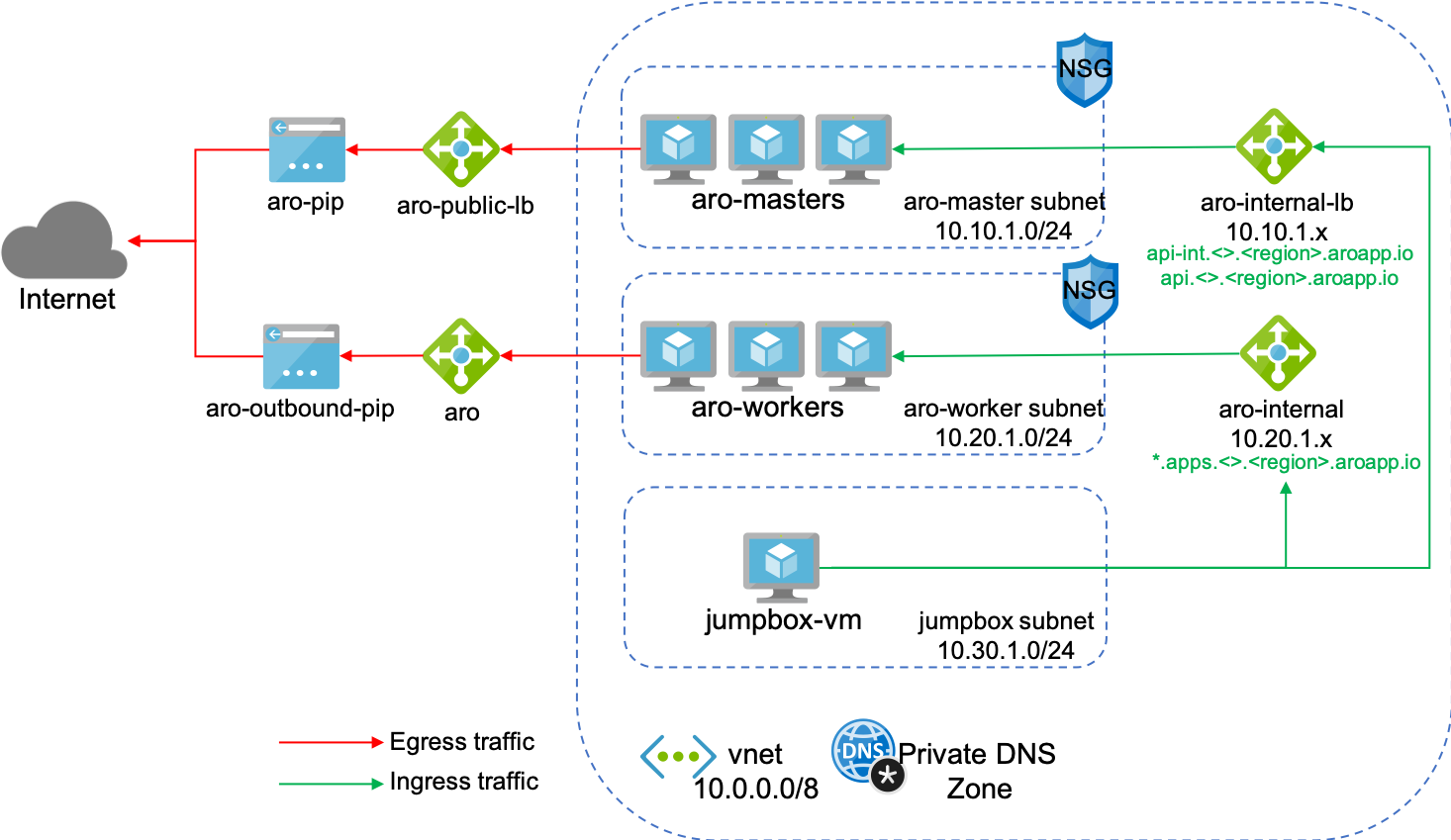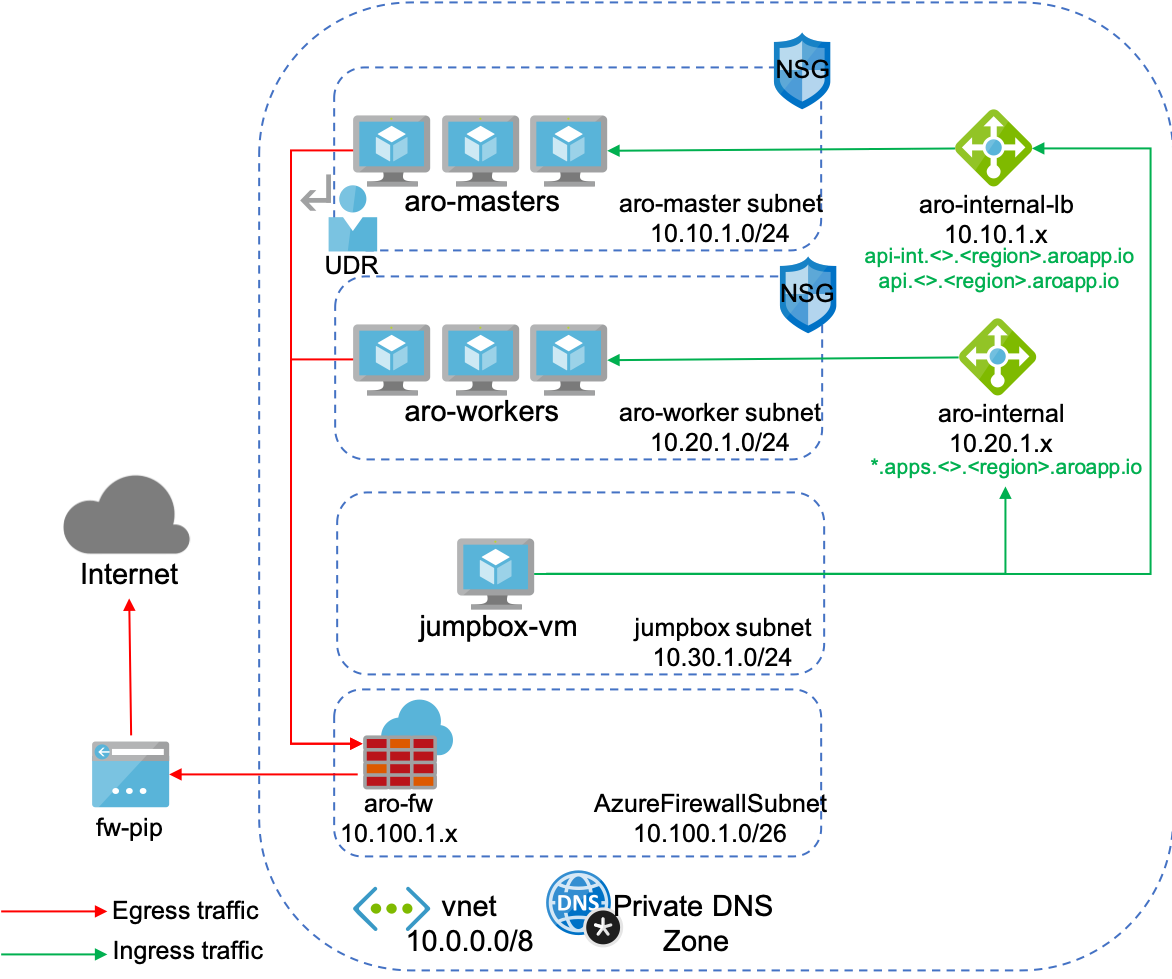The goal is to secure ARO cluster by routing Egress traffic through an Azure Firewall
Not necessary
az extension add -n aro --index https://az.aroapp.io/stable
az extension update -n aroLOCATION=westeurope
RESOURCEGROUP=aro-v4-private
CLUSTER=aroprivateaz group create -g "$RESOURCEGROUP" -l $LOCATIONaz network vnet create \
-g "$RESOURCEGROUP" \
-n vnet \
--address-prefixes 10.0.0.0/8 az network vnet subnet create \
-g "$RESOURCEGROUP" \
--vnet-name vnet \
-n "$CLUSTER-master" \
--address-prefixes 10.10.1.0/24 \
--service-endpoints Microsoft.ContainerRegistry
az network vnet subnet create \
-g "$RESOURCEGROUP" \
--vnet-name vnet \
-n "$CLUSTER-worker" \
--address-prefixes 10.20.1.0/24 \
--service-endpoints Microsoft.ContainerRegistryDisable network policies for Private Link Service on your virtual network and subnets. This is a requirement for the ARO service to access and manage the cluster.
az network vnet subnet update \
-g "$RESOURCEGROUP" \
--vnet-name vnet \
-n "$CLUSTER-master" \
--disable-private-link-service-network-policies trueaz network vnet subnet create \
-g "$RESOURCEGROUP" \
--vnet-name vnet \
-n "AzureFirewallSubnet" \
--address-prefixes 10.100.1.0/26 az network vnet subnet create \
-g "$RESOURCEGROUP" \
--vnet-name vnet \
-n "jumphost" \
--address-prefixes 10.30.1.0/24 \
--service-endpoints Microsoft.ContainerRegistryVMUSERNAME=aroadmin
az vm create --name ubuntu-jump \
--resource-group $RESOURCEGROUP \
--ssh-key-values ~/.ssh/id_rsa.pub \
--admin-username $VMUSERNAME \
--image UbuntuLTS \
--subnet "jumphost" \
--public-ip-address jumphost-ip \
--vnet-name vnet Get a pull-secret value from Red Hat Customer Portal and store it in a variables:
PULL_SECRET='<your_pull_secret>'az aro create \
-g "$RESOURCEGROUP" \
-n "$CLUSTER" \
--vnet vnet \
--master-subnet "$CLUSTER-master" \
--worker-subnet "$CLUSTER-worker" \
--apiserver-visibility Private \
--ingress-visibility Private \
--pull-secret $PULL_SECRETaz network public-ip create -g $RESOURCEGROUP -n fw-ip --sku "Standard" --location $LOCATIONaz extension add -n azure-firewall
az extension update -n azure-firewallaz network firewall create -g $RESOURCEGROUP -n aro-private -l $LOCATION
az network firewall ip-config create -g $RESOURCEGROUP -f aro-private -n fw-config --public-ip-address fw-ip --vnet-name vnet
FWPUBLIC_IP=$(az network public-ip show -g $RESOURCEGROUP -n fw-ip --query "ipAddress" -o tsv)
FWPRIVATE_IP=$(az network firewall show -g $RESOURCEGROUP -n aro-private --query "ipConfigurations[0].privateIpAddress" -o tsv)
echo $FWPUBLIC_IP
echo $FWPRIVATE_IPaz network route-table create -g $RESOURCEGROUP --name aro-udr
az network route-table route create -g $RESOURCEGROUP --name aro-udr --route-table-name aro-udr --address-prefix 0.0.0.0/0 --next-hop-type VirtualAppliance --next-hop-ip-address $FWPRIVATE_IPRule for OpenShift to work based on this list:
az network firewall application-rule create -g $RESOURCEGROUP -f aro-private \
--collection-name 'OpenShift' \
--action allow \
--priority 100 \
-n 'required' \
--source-addresses '*' \
--protocols 'http=80' 'https=443' \
--target-fqdns 'registry.redhat.io' '*.quay.io' 'sso.redhat.com' 'management.azure.com' 'mirror.openshift.com' 'api.openshift.com' 'quay.io' '*.blob.core.windows.net' 'gcs.prod.monitoring.core.windows.net' 'registry.access.redhat.com' 'login.microsoftonline.com' '*.servicebus.windows.net' '*.table.core.windows.net' 'grafana.com'Optional rules for Docker images:
az network firewall application-rule create -g $RESOURCEGROUP -f aro-private \
--collection-name 'Docker' \
--action allow \
--priority 200 \
-n 'docker' \
--source-addresses '*' \
--protocols 'http=80' 'https=443' \
--target-fqdns '*cloudflare.docker.com' '*registry-1.docker.io' 'apt.dockerproject.org' 'auth.docker.io'az network vnet subnet update -g $RESOURCEGROUP --vnet-name vnet --name "$CLUSTER-master" --route-table aro-udr
az network vnet subnet update -g $RESOURCEGROUP --vnet-name vnet --name "$CLUSTER-worker" --route-table aro-udrThese steps works only if you added rules for Docker images.
Log into a jumpbox VM and install azure-cli, oc-cli, and jq utils. For the installation of openshift-cli check the Red Hat customer portal.
#Install Azure-cli
curl -sL https://aka.ms/InstallAzureCLIDeb | sudo bash
#Install jq
sudo apt install jq -y
#Install aro extension
az extension add -n aro --index https://az.aroapp.io/stableList cluster credentials:
# Initialize variables
LOCATION=eastus
RESOURCEGROUP=aro-v4-private
CLUSTER=aroprivate
# Login to Azure
az login
#Get the cluster credentials
ARO_PASSWORD=$(az aro list-credentials -n $CLUSTER -g $RESOURCEGROUP -o json | jq -r '.kubeadminPassword')
ARO_USERNAME=$(az aro list-credentials -n $CLUSTER -g $RESOURCEGROUP -o json | jq -r '.kubeadminUsername')Get an API server endpoint:
ARO_URL=$(az aro show -n $CLUSTER -g $RESOURCEGROUP -o json | jq -r '.apiserverProfile.url')Log in using oc login:
oc login $ARO_URL -u $ARO_USERNAME -p $ARO_PASSWORDCreate a pod
cat <<EOF | oc apply -f -
apiVersion: v1
kind: Pod
metadata:
name: centos
spec:
containers:
- name: centos
image: centos
ports:
- containerPort: 80
command:
- sleep
- "3600"
EOFOnce the Pod is Running exec into it and test outside connectivity
oc exec -it centos -- /bin/bash
curl microsoft.comCreate a welcome-app deployment:
oc apply -f https://raw.githubusercontent.com/akamenev/aro-private/master/welcome-app-deployment.yamlCreate a welcome-app service with a ClusterIP:
oc apply -f https://raw.githubusercontent.com/akamenev/aro-private/master/welcome-app-clusterip-svc.yamlExpose a welcome-app service via route:
oc expose service welcome-appCheck the service
APP_ROUTE=$(oc get route welcome-app -o json | jq -r .spec.host)
curl $APP_ROUTECreate a welcome-app service with an Internal LB:
oc apply -f https://raw.githubusercontent.com/akamenev/aro-private/master/welcome-app-internallb-svc.yamlGet the internal IP of a service:
INTERNAL_APP_IP=$(oc get svc welcome-app-internal -o json | jq -r '.status.loadBalancer.ingress[0].ip')Configure a DNAT rule in Azure Firewall:
# Get a Firewall's public ip
FWPUBLIC_IP=$(az network public-ip show -g $RESOURCEGROUP -n fw-ip --query "ipAddress" -o tsv)
echo $FWPUBLIC_IP
# Add a firewall extension
az extension add -n azure-firewall
# Configure a rule
az network firewall nat-rule create -g $RESOURCEGROUP -f aro-private \
--collection-name 'welcome-app-nat' \
--priority 100 \
--action 'Dnat' \
-n 'welcome-app' \
--source-addresses '*' \
--destination-address $FWPUBLIC_IP \
--destination-ports '80' \
--translated-address $INTERNAL_APP_IP \
--translated-port '80' \
--protocols 'TCP'Open Firewall's public IP in a browser or curl it:
curl $FWPUBLIC_IP
